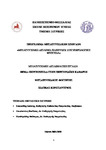Encapsulating peritoneal sclerosis: Pathophysiology and current treatment options
Date
2019Language
en
Sujet
Résumé
Encapsulating peritoneal sclerosis (EPS) is a life-threatening complication of long-term peritoneal dialysis (PD), which may even occur after patients have switched to hemodialysis (HD) or undergone kidney transplantation. The incidence of EPS varies across the globe and increases with PD vintage. Causative factors are the chronic exposure to bioincompatible PD solutions, which cause long-term modifications of the peritoneum, a high peritoneal transporter status involving high glucose concentrations, peritonitis episodes, and smoldering peritoneal inflammation. Additional potential causes are predisposing genetic factors and some medications. Clinical symptoms comprise signs of intestinal obstruction and a high peritoneal transporter status with incipient ultrafiltration failure. In radiological, macro-, and microscopic studies, a massively fibrotic and calcified peritoneum enclosed the intestine and parietal wall in such cases. Empirical treatments commonly used are corticosteroids and tamoxifen, which has fibrinolytic properties. Immunosuppressants like azathioprine, mycophenolate mofetil, or mTOR inhibitors may also help with reducing inflammation, fibrin deposition, and collagen synthesis and maturation. In animal studies, N-acetylcysteine, colchicine, rosiglitazone, thalidomide, and renin-angiotensin system (RAS) inhibitors yielded promising results. Surgical treatment has mainly been performed in severe cases of intestinal obstruction, with varying results. Mortality rates are still 25–55% in adults and about 14% in children. To reduce the incidence of EPS and improve the outcome of this devastating complication of chronic PD, vigorous consideration of the risk factors, early diagnosis, and timely discontinuation of PD and therapeutic interventions are mandatory, even though these are merely based on empirical evidence. © 2019 by the authors. Licensee MDPI, Basel, Switzerland.
Collections
Related items
Showing items related by title, author, creator and subject.
-
Aeromonas hydrophila as a causative organism in peritoneal dialysis-related peritonitis: case report and review of the literature
Liakopoulos, V.; Arampatzis, S.; Kourti, P.; Tsolkas, T.; Zarogiannis, S.; Eleftheriadis, T.; Giannopoulou, M.; Stefanidis, I. (2011)Most episodes of peritoneal dialysis (PD)-related peritonitis could be attributed to a single organism, but in almost 10% of peritonitis episodes multiple organisms are identified. Polymicrobial peritonitis is often related ... -
Gross calcification of the small bowel in a continuous ambulatory peritoneal dialysis patient with sclerosing peritonitis
Poultsidi, A.; Liakopoulos, V.; Eleftheriadis, T.; Zarogiannis, S.; Bouchlariotou, S.; Stefanidis, I. (2006)We present here the case of a continuous ambulatory peritoneal dialysis (CAPD) patient who developed sclerosing calcifying peritonitis with gross macroscopic calcification of the small bowel, a rare and life-threatening ... -
Περιτονίτιδα στην περιτοναϊκή κάθαρση
Σιάπκας, Κωνσταντίνος (2020)
